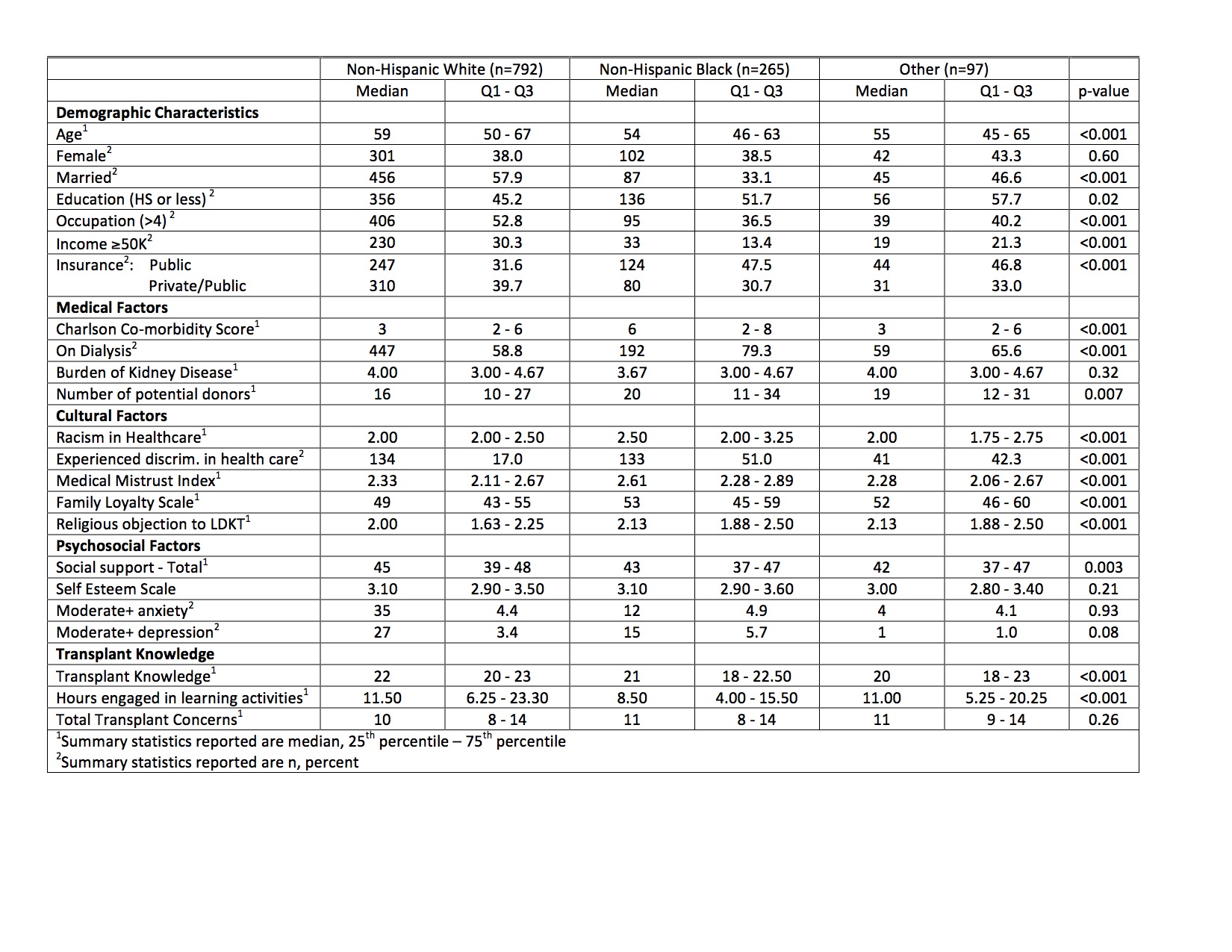Non-Medical Factors Contributing to Racial Disparity in Kidney Transplant Wait-Listing.
Y.-H. Ng,1 S. Pankratz,1 K. Bornemann,2 E. Croswell,2 J. Pleis,2 R. Shapiro,3 M. Unruh,1 L. Myaskovsky.2
1Medicine, Nephrology, University of New Mexico, Albuquerque, NM
2Department of Medicine, University of Pittsburgh, Pittsburgh, PA
3Department of Surgery, Mount Sinai Hospital, New York, NY
Meeting: 2017 American Transplant Congress
Abstract number: C50
Keywords: African-American, Patient education, Psychosocial, Waiting lists
Session Information
Session Name: Poster Session C: Disparity in Access and Outcomes for Solid Organ Transplantation
Session Type: Poster Session
Date: Monday, May 1, 2017
Session Time: 6:00pm-7:00pm
 Presentation Time: 6:00pm-7:00pm
Presentation Time: 6:00pm-7:00pm
Location: Hall D1
Background: African American (AA) and other minorities (OM) are known to have disproportionately higher incidence of end-stage kidney disease (ESKD) but lower rates of kidney transplantation (KT) compared to white patients (WH). This disparity has persisted even after accounting for medical factors. In this study, we assessed the relationship of non-medical (e.g., cultural, psychosocial, knowledge) factors associated with KT wait-listing within the context of potential racial/ethnic differences.
Methods: We conducted a longitudinal cohort study using telephone interviews with 1154 ESKD patients who were referred for KT evaluation. We used Kruskal-Wallis and chi-square tests to examine race differences in cultural, psychosocial, and knowledge factors and then used Cox proportional hazards regression in multivariate analyses that examined these factors as potential predictors of KT wait-listing, together with race/ethnicity.
Results: As noted in Fig.1, significant differences were noted in the baseline characteristics in the 3 groups. AA and OM were younger, less educated, had lower income, and were less likely to be married, but more likely to experience discrimination compared to WH. Even though both AA and OM had more potential donors, they were less likely to be wait-listed compared to WH. Younger age, having private insurance, fewer comorbidities, more social support, and greater transplant knowledge predicted KT wait-listing. However, accounting for these factors did not explain the observed racial/ethnic disparities, and income level was found to differentially affect KT wait-listing by race/ethnicity.
Younger age, having private insurance, fewer comorbidities, more social support, and greater transplant knowledge predicted KT wait-listing. However, accounting for these factors did not explain the observed racial/ethnic disparities, and income level was found to differentially affect KT wait-listing by race/ethnicity.
Conclusion: Non-medical factors contribute to racial disparity in KT wait-listing. Developing intervention to target known non-medical risk factors for disparities in KT wait-listing is required to allow equal access to KT.
CITATION INFORMATION: Ng Y.-H, Pankratz S, Bornemann K, Croswell E, Pleis J, Shapiro R, Unruh M, Myaskovsky L. Non-Medical Factors Contributing to Racial Disparity in Kidney Transplant Wait-Listing. Am J Transplant. 2017;17 (suppl 3).
To cite this abstract in AMA style:
Ng Y-H, Pankratz S, Bornemann K, Croswell E, Pleis J, Shapiro R, Unruh M, Myaskovsky L. Non-Medical Factors Contributing to Racial Disparity in Kidney Transplant Wait-Listing. [abstract]. Am J Transplant. 2017; 17 (suppl 3). https://atcmeetingabstracts.com/abstract/non-medical-factors-contributing-to-racial-disparity-in-kidney-transplant-wait-listing/. Accessed December 28, 2025.« Back to 2017 American Transplant Congress
